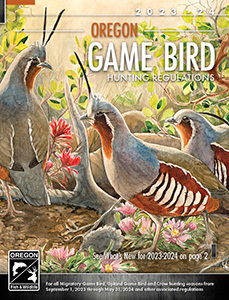Small Game Hunting
Small game species provide a variety of hunting opportunities throughout the state and are an excellent way to introduce new hunters to hunting. Only the appropriate hunting license is necessary to hunt small game (no tags or permits). The western gray squirrel is a “game mammal” with specific season dates. Many species of what hunters consider “small game” are “unprotected mammals”.
Western Gray Squirrel
A hunting license is required to hunt western gray squirrels. Western gray squirrels can only be hunted during the seasons listed below.
North - Central Oregon
Open Season: Sept. 15 - Oct. 31
Bag Limit: 3 squirrels daily.
Possession Limit: 6 in possession.
Open Area: Units 34, 35, 39, 41 and 42.
Remainder of the State
Open Season: Sept. 1 - Nov. 15
Bag Limit: 5 squirrels daily.
Possession Limit: 15 in possession.
Open Area: Units 10-33, 36-38, 40, 43-77.
Exception: No bag limit or closed season in that part of Unit 30 south of Rogue Rvr and S Fork Rogue Rvr and north of Hwy 140.
See Big Game Hunting Regulations for WMU boundary descriptions.
Unprotected Mammals
Unprotected mammals are not covered under the game mammal, furbearer, or sensitive species rules. For unprotected mammals, there are no closed seasons or bag limits. However, a hunting license is required and all general hunting regulations still apply. Commonly hunted unprotected mammals include coyote, cottontail rabbits, black-tailed jackrabbit, opossum, nutria, California ground squirrel, and Belding’s ground squirrels.

